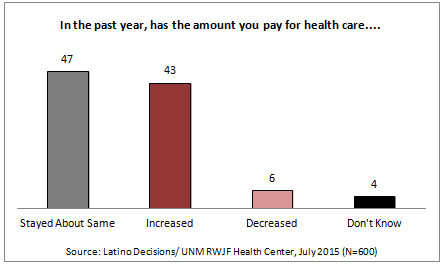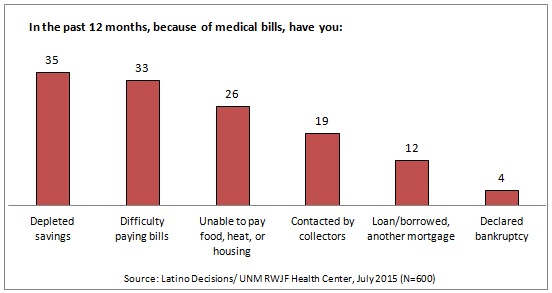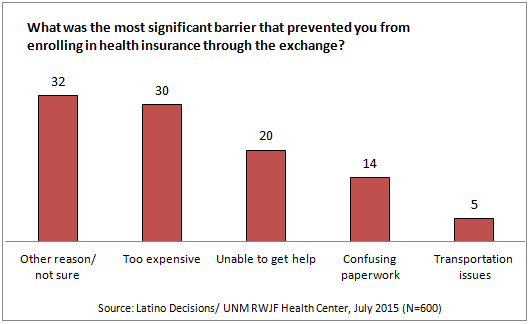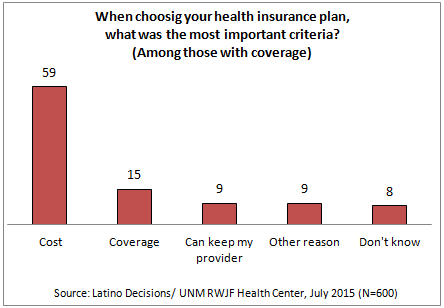A new poll of Latino/Hispanic adults in New Mexico funded by the National Institute of Health provides an opportunity to explore New Mexican Hispanics’ interactions with and attitudes toward health care reform. The poll, commissioned by the Robert Wood Johnson Foundation Center for Health Policy (RWJF-CHP) along with NMCARES-Health Disparities Center, and administered by Latino Decisions, queried 600 Latino/Hispanic adults living in New Mexico regarding their knowledge of the new health care law, exposure to outreach efforts, perception of their own health care as impacted by the law, and their actual experience with the state’s exchange program. We focus our attention in this policy brief on the costs associated with health care and find that financial costs remain a significant barrier to care for many Hispanic adults in New Mexico, and is a major factor driving health care decisions. Although this is the first poll of this kind conducted in New Mexico, the results from this study can be compared to results from a similar poll conducted in Colorado in 2013 that also included measures related to knowledge and familiarity with the Affordable Care Act (ACA). Additionally, these findings can be compared to findings from the recent Latino National Immigration and Health Survey (2015).
Economic Context
Even if small, any increased costs associated with health care at the individual level could be devastating to Hispanics in New Mexico given the economic challenges currently facing the state’s population. According to the U.S. Census Bureau, in 2013 20.4% of New Mexicans were below the poverty level, compared to the national rate of 14.5%. As has been well documented, poverty is even a greater concern for the children of the state, with 28.9% of children in New Mexico below the poverty level, compared to 19.9% at the national level. Hispanic children are more likely to live in poverty than non-Hispanic white children. In 2013, the median household income of New Mexican residents was 16% lower than the national rate, at $44,026 compared to $52,250.
New Mexico’s economy has also been slow to rebound from the recession. From 2010 to 2013, states across the nation saw an average increase of $1,106 in their median household income, while New Mexico only had an increase of $546. Although the annual average unemployment rate of New Mexico has decreased from 8.1% to 6.5% between 2010 and 2014, New Mexico’s unemployment rate remains the 46th worst in the nation. Our survey results regarding health care costs should be interpreted against the backdrop of the state’s overall economic reality.
Health Care Costs Taking a Toll
Results from the New Mexico Hispanic ACA and Health Survey strongly suggest that the costs associated with health care pose significant challenges to the already disadvantaged Hispanic community in New Mexico. This is apparent across a number of items measured in the new poll, including a set of questions that asked respondents directly whether any of a number of specific issues were problematic for them over the past year. We found that 48% of respondents found the costs for paying for health care including co-pays was a problem, with 24% indicating that this was a major problem. This is significantly higher than difficulties communicating with providers, access to a permanent place to go for health care, or access to health care due to transportation or distance from a provider. The only issue that is comparable to the costs for paying for health care in our battery was the wait time to get an appointment to see a doctor .
The survey also asked respondents to provide an assessment of whether the costs of their health care had changed over the past year. As depicted in the figure below, while the modal response category was stayed about the same, a robust 43% of respondents indicated that the costs of their care have increased, compared to only 6% who reported that the costs of their care had decreased. Among those who saw their heath costs rise, 71% said the increase costs pose a financial burden.

The survey also provides the opportunity to better understand the impact of medical care costs to Hispanic families in New Mexico through the responses to questions specifically aimed at understanding the relationship between costs and medical seeking behavior and the impact of medical bills on a household’s overall financial situation. The figure below illustrates how the cost of medical care influences how this population interacts with the health care system. We find 40% relied on home remedies or over the counter drugs instead of seeing a doctor, 36% postponed getting health care they needed, 36% skipped dental care, 24% did not fill a prescription, and 22% cut pills in half or skipped doses. Another 28% reported they have skipped a medical test or treatment, suggesting that preventative care will need to be more affordable if utilized more universally. Finally, one out of every ten Hispanic adults in New Mexico had difficulty getting mental health care due to the costs.

The survey explores how the cost of medical bills may be causing overall financial stress among Hispanics in New Mexico. We believe that this is the most compelling data related to this aspect of the survey, as the consequences of rising medical bills have been devastating to many Hispanic families over the past year. For example, over a third (35%) of Hispanics have used up all or most of their savings because of medical bills, and a third (33%) have had difficulty paying other bills. Many Hispanic families also have to make tough decisions regarding which bills to pay, with 26% indicating that they have been unable to pay for necessities like food, heat, or housing because of medical bills. In the past year, 12% of Hispanic New Mexicans have had to borrow money, get a loan or get another mortgage due to medical costs. Finally, we find that nearly 20% of Hispanics in New Mexico have been contacted by a collection agency and 4% have had to declare bankruptcy due to their medical bills. When taken as a whole, the survey provides clear evidence that Hispanic families in New Mexico are having a difficult time handling the rising costs of health care at a time when the state’s economy continues to remain stagnant.

Cost is Biggest Barrier to Insurance
The survey also included questions specific to those who attempted to enroll in the New Mexico exchange but were not able to do so. For example, we asked what was the most significant barrier that prevented you from enrolling? As depicted in the figure below, nearly a third (30%) reported that insurance was too expensive, compared to smaller percentages who said it was due to not being able to understand the paperwork (14%) or being able to get assistance near home or work (20%). We also asked the full sample that did not enroll through the New Mexico exchange the main reason that they did not sign up. Although lower than those who reported that they were satisfied with their current coverage, 15% indicated that they did not enroll because it was too expensive.

The next indicator of how much costs of insurance is serving as a barrier to access to coverage for Hispanic New Mexicans is illustrated by the figure below. Here we asked respondents who reported that they were under-insured at some point in the last year what the main reason was that they did not have insurance. We see here that while more than a third of the sample reported that it was because the insurance systems were too hard to figure out, another 26% reported that they could not afford it. When taken together, these measures reveal that the cost and complexity of acquiring health insurance is an obstacle to coverage for many Hispanic adults and families in New Mexico.

Finally, the survey also queried respondents who were able to enroll in health insurance through the NM-HIX what the important criteria was for them when choosing their health insurance plan. Consistent with the overall theme of this brief, a robust 59% of Hispanic adults indicated that the cost of the plan was the most important criteria (see figure below). This compares to a much smaller percentage who reported that it was the coverage of the plan (15%) or the ability to stay with current healthcare provider at 9%.

Methodology: Latino Decisions surveyed a representative sample of 600 Hispanic/Latino adults in New Mexico between June 16 and July 14, 2015. Surveys were implemented to randomly selected phone numbers, conducted via live, person-to-person (i.e. not robocalls) phone calls, and online. Interviews were conducted in English or Spanish, according to the respondent’s choice. The survey carries a margin of error of +/- 4 percentage points.
This study was supported by the National Institute on Minority Health and Disparities of the National Institutes of Health under Award Number P20MD009574. The content is solely the responsibility of the authors and does not necessarily represent the official views of the National Institutes of Health.
Gabriel R. Sanchez is an Associate Professor of Political Science at the University of New Mexico (UNM), the Executive Director of the RWJF Center for Health Policy at UNM, and the Director of Research for Latino Decisions.
Sam Howarth is a Senior Fellow of the RWJF Center for Health Policy and a Research AssistantProfessor in the Department of Economics at UNM.
Maria Livaudais is a PhD candidate in Political Science and a UNM Center for Health Policy Fellow at UNM. . Bárbara Gómez-Aguiñaga is a PhD student in Political Science and a Research Assistant at the RWJF Center for Health Policy at UNM.


